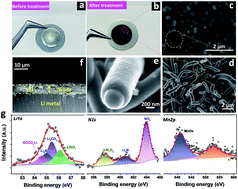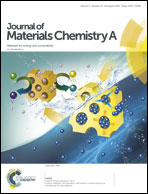An ultrafast rechargeable lithium metal battery†
Abstract
Rechargeable lithium metal batteries have been regarded as one of the most attractive high-energy-density batteries due to their large specific capacity and the lowest reduction potential of metallic lithium. However, the uncontrollable Li dendrite growth and the resulting unstable interfaces during repeated Li plating/stripping lead to severe safety issues and a short cycle life, which are aggravated especially at a high current density. Herein, we present an organic/inorganic composite protective layer via pretreating the lithium metal in an Mn(NO3)2-containing carbonate electrolyte, not only enabling stable lithium deposition and formation with a prolonged cycle life, but also providing a record high rate of 20 mA cm−2 with a minimized overpotential of 60 mV in a symmetric lithium cell. Results indicate that such an artificial protective film could effectively prolong the cycle life of Li|Cu cells, and greatly improve the comprehensive electrochemical performance of Li|LiMn2O4 cells. The pretreated-Li|LiMn2O4 cells show an outstanding cycling performance with 83% capacity retention over 200 cycles at a high rate of 2C and a high temperature of 55 °C, and exhibit robust recovery capabilities with a high capacity and coulombic efficiency after the cycles at 10C. These findings highlight the significance of a protective layer in stabilizing a Li metal anode and pave a new way for designing high-energy batteries for practical utilization.



 Please wait while we load your content...
Please wait while we load your content...